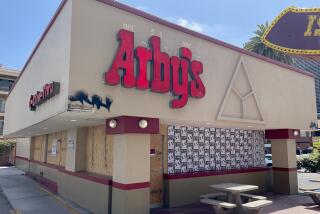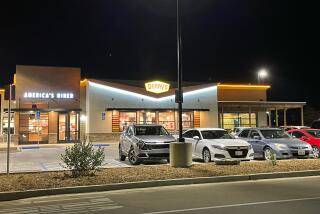Window Shopping : Let It Ride: Drivers Can Pick Up Burgers, Drop Off Toxics, Pay Last Respects From Behind the Wheel
- Share via
Keep your seat belts fastened. Crank the emergency brake, dig for your wallet and roll down that window.
It’s a drive-through life.
Reach out and pay for something--hamburgers, dry cleaning, car insurance, car washes, newspapers, oranges, flowers, film, postage stamps, oil changes, movies and more.
The drive-through concept has been around since vendors first tossed their wares into the horse and buggy. But the idea began gathering steam about five years ago, according to Rex Beaber, a Century City psychologist and attorney.
Women once stayed at home and performed the bulk of household errands, Beaber said. But with both husband and wife working, errands are now run during lunch hours and in transit to work--with seat belts securely fastened.
“Time became the most valuable commodity in the family system,” Beaber said. “And the phenomenon is more prevalent in larger geographic areas like the San Fernando Valley. There’s going to be pressure to purchase everything from drive-through windows.”
Besides the common fare of hamburgers and fries, more innovative uses of the car window transom are on the horizon.
To reduce lengthy lines at the state Department of Motor Vehicles, the department will open a drive-through kiosk in mid-September. The mini-office, in the parking lot of the Van Nuys office, will dispense driver training manuals, driving record printouts and car registration renewal stickers.
“This will be the first of its kind in the state,” said office manager Diane Ward, who works in the Van Nuys division. “Everyone’s life style is changing, so we’re trying to keep up with the changes. Mothers with kids won’t have to get out of the car or hire a baby-sitter to visit the DMV.”
On the heels of the DMV, the Los Angeles Department of Public Works has arrived at a method of disposing of household toxic wastes--drive-through toxic waste dumps.
Temporary collection locations are announced every few months through a program begun last year. Drivers arrive to drop off paint, dirty oil, garden pesticides, aerosols and other toxic substances.
“When you enter the lot with your car, one person asks questions about what kind of stuff you have, one person takes your car keys and opens the trunk for you and others take the stuff out,” said Chuck Ellis, department spokesman. “Then we close your trunk, and off you go.”
The process, which began as a two-hour walk-in ordeal for participants, has been pared down to a 15-minute wait with the drive-through concept, Ellis said. For upcoming drop-off dates in the Valley during November, January and April, call (213) 237-1634.
Hamburgers are perhaps the most popular commodity purchased through car windows. The first In-N-Out Burger opened in Baldwin Park in 1948. There are now 55 In-N-Out Burger restaurants in Southern California.
Tony Scarnechia, 19, frequents the Woodland Hills In-N-Out Burger, waiting for as long as 20 minutes in lines that spill out onto Ventura Boulevard to pick up hamburgers on his lunch hour. “Sometimes you end up on the left side window of a two-lane drive-through and you’re the only passenger. You have to reach over and roll down the window and try to hand over the money.”
McDonald’s, founded in 1955, opened its first drive-through as recently as 1974 in Oklahoma City. Most of its 10,720 restaurants (a new location opens every 15 hours) have drive-through windows.
A few grocery stores still offer drive-through food services. Alta-Dena Dairy began its drive-through service in 1949, four years after opening its first plant in Monrovia. Once there were 70 such drive-through stores. All but three--in Chatsworth, Hawthorne and the City of Industry--have been sold.
“It really took off, everyone loved it,” said former Alta-Dena owner Harold Stueve, 71. “It’s a fast way of getting your milk.”
Kevin Jones, 17, mans an Alta-Dena store in West Hills that is no longer part of the chain, dashing in and out of the shop to hand over mostly bread and dairy products to customers who pull up under a carport.
“There’s one lady with 10 kids who comes through every week and orders 12 gallons of milk,” Jones said as he delivered a bottle of A-1 Sauce and a pack of Benson & Hedges through the window of a Ford van. “She comes back in a few days and orders the same thing.”
Grocery stores rarely offer curbside service because “food selection is so individual and personal,” Beaber said, adding that a West Los Angeles drive-through warehouse grocery once tried the concept but failed. “People are reluctant to have someone else choose their fruits and vegetables. For items that don’t require discretion, like dairy and bread, it’s a good concept.”
A San Ysidro Jack-in-the-Box restaurant gave Oscar Padilla, owner of Oscar Padilla Mexican Insurance in San Ysidro, the idea for building the first drive-through insurance shop in 1969.
“I had an office at the time adjoining Jack-in-the-Box,” Padilla said. “I observed how they were handling traffic.” Padilla now sells about 100,000 policies each year to drivers who pull up to either side of his three locations in San Ysidro and Calexico. The policies insure American drivers whose insurance does not cover accidents in foreign countries. Padilla said four other insurance companies followed his lead and also operate drive-throughs in the vicinity.
Drive-through oil change shops for cars first opened about 10 years ago, beginning on the East Coast before spreading to other states.
“Sometimes people drive right into our pit,” said Pete Bischoff, manager of Lube Pit Stop in Canoga Park. He added that customers sometimes go off the tracks. “If they don’t aim correctly, they just go right in. It takes three guys to lift up the car and move it out.” Of course, the customers usually stay in their cars while oil is being changed.
Drive-through automatic teller machines were first created in the minds of science fiction writers, such as Ray Bradbury, who described a bank in “Fahrenheit 451” as being “open all night every night with robot tellers in attendance.” Those words were written in the late 1940s.
Today, 226,000 “robot tellers” dot the globe, a fair portion of them drive-throughs, according to the American Bankers Assn. “The first was opened on June 27, 1967 at Barclays Bank in Enfield, England,” said Ed Alwood, spokesperson for the organization. “It was like the Wright Brothers of ATMs.”
As a test, the U.S. Postal Service is using a bank automated teller machine in Seattle to dispense stamps. The concept may be expanded to a drive-through service in the future.
The state of California most likely boasted the world’s first and only drive-through tree, a giant Sequoia in the southern part of Yosemite National Park. Carriages began driving through the tree soon after a tunnel, 9 feet high by 8 feet wide and 26 feet long, was cut through in 1881.
But the tree, named “Wawona,” fell over in the winter of 1969, partly because of root damage from heavy traffic, according to Park Ranger Fermin Salas.
Some states, especially those in the South, are famous for even stranger drive-through concepts, such as drive-through mortuaries.
In Greer, S.C., Sullivan Brothers Mortuary on Poinsette Street caters to motorists on the run.
“We put a drive-through in about 20 years ago when we built the place,” said Warren Sullivan, a part-owner in the family-run business.
Local mortuary owners doubt if the idea will gain ground in Southern California. “I don’t think the public is quite ready for it,” said Ralph Crawford, owner of Crawford Mortuary in Northridge. “I’ve never had a request for it, let me put it that way.”
Sullivan said viewers at his mortuary simply drive up to a 3-foot-by-4-foot window, pay their respects, sign a register and move on. “The remains are turned around to the window to the outside,” he said. “I knew of one in Atlanta and so I happened to build it that way.
“I just knew it would be a good idea.”
More to Read
Inside the business of entertainment
The Wide Shot brings you news, analysis and insights on everything from streaming wars to production — and what it all means for the future.
You may occasionally receive promotional content from the Los Angeles Times.










